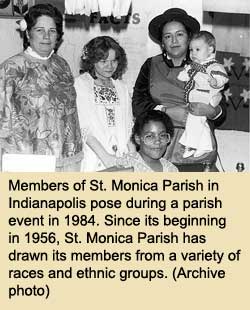In its first 50 years, St. Monica Parish celebrates growth, diversity

By Sean Gallagher
 The years following the end of World War II were a period of great change in the United States.
The years following the end of World War II were a period of great change in the United States.
The economy expanded greatly, along with the overall population, in the “baby boom.”
But it was also a time when the struggle for civil rights among African-Americans came to the forefront.
In the midst of these historic developments, the Archdiocese of Indianapolis was changing as well.
From 1946-56, 11 parishes were established in Marion County alone.
St. Monica Parish, on the northwest side of Indianapolis, was the last of these, although more continued to be established in the years following.
A celebration of the 50th anniversary of the founding of St. Monica Parish will be held on Aug. 26 at the faith community’s church at 6131 N. Michigan Road.
It will start with a 5:30 p.m. Mass celebrated by Archbishop Daniel M. Buechlein and concelebrated by its current pastor, Msgr. Paul Koetter, and other priests who have been assigned to the parish over the past half century.
Reflecting the trends of the times, St. Monica was founded in an area where new subdivisions were being built for the G.I.s who came home from the war and were starting families.
One of these veterans, Bob Lang, was a founding member of the parish.
He served in the Pacific in the Army Air Force while Margaret Davis, the woman who would later become his wife, worked at factories in Indianapolis that supported the war effort.
They married in 1949, and eventually moved to what would later become 79th Street on Indianapolis’ northwest side.
When the family moved there, it was the gravel road upon which Lang’s children learned to ride their bicycles. Today, it is a bustling thoroughfare that he says you can “hardly walk across.”
Despite all the great changes that happened in the area around their home during the last 50 years, Lang said his faith has been a constant for him.
“I think the [parish] has influenced that,” he said. “We know more people around here who belong to St. Monica—a lot of young people. They’re the ones that are going to be running the [parish]. But we still have to keep interested in things like Bible study.”
According to retired Father John Luerman, St. Monica’s first assistant pastor, the parish—like the rest of the population—also grew very quickly in its early years.
“When I first went out there, it was just growing so fast. There were so many people moving in,” said Father Luerman, who served at the parish from 1959-68.
“I just fell in love with St. Monica. Even as it was growing so fast, I just worked hard at getting to know everybody when they came into the parish. It was just an exciting place to be.”
St. Monica Parish, from its earliest days, also had members that came from a diversity of racial and ethnic backgrounds.
That broad panorama of people who come together to worship, educate children in the parish’s school and grow in faith has only continued to increase as people from around the world have moved into the parish’s surrounding neighborhoods.
“I think one of the things that we celebrate is that diversity and that mix of backgrounds that comes together at St. Monica’s,” said Msgr. Koetter. “There’s a real richness in the experiences and backgrounds of so many people there.”
The diversity that is celebrated had some growing pains early on, however, according to longtime parishioner Carrie Kemp.
She and her husband, David, both African-American, were married at Holy Angels Church in Indianapolis. They later moved further north and joined St. Monica Parish in 1964.
“You could feel that it didn’t have the same warmth that we had at other churches,” she said. “I regret that the early years were more or less difficult for us. But we overcame it, and we’re just sailing along now.”
In 2004, Kemp helped found the Black Catholic Ministry, one of the dozens of lay ministries at St. Monica Parish. Among other projects, that group has sought to keep young college students from the parish connected to their faith when they go off to school.
“We come together and want to have fellowship,” she said. “But it’s not a racial thing. We don’t want it to be just for the black Catholics. We want everyone involved.”
As Msgr. Koetter looks forward to the next 50 years of the life of St. Monica Parish, he thinks that the growth of its Hispanic community will play an important role.
“One of the things you sense is that St. Monica’s is a pretty welcoming and hospitable community,” he said. “The Hispanic community is an example of that right now. So I think, as we continue to move into the future, openness to the Hispanic community, and continuing to serve [them] and incorporating them into the parish, will certainly be a part of our future.”
No matter what ethnic or racial background its members come from, no matter if they served in World War II or are the grandchildren of America’s “greatest generation,” the people who make up St. Monica are filled with stories of how the faith community has shaped their lives in a positive way.
With that in mind, a DVD of its members sharing tales of the first 50 years of the life of St. Monica Parish will soon be made available to the public.
(For more information about this DVD, call the St. Monica Parish office at
317-253-3342.) †
